Table of Contents
1 Industry Overview of 2,5-Xylenol
1.1 Definition and Specifications of 2,5-Xylenol
1.1.1 Definition of 2,5-Xylenol
1.1.2 Specifications of 2,5-Xylenol
1.2 Classification of 2,5-Xylenol
1.3 Applications of 2,5-Xylenol
1.3.1 Nuclear Application
1.3.2 Non-Nuclear Application
1.4 Industry Chain Structure of 2,5-Xylenol
1.5 Industry Overview and Major Regions Status of 2,5-Xylenol
1.5.1 Industry Overview of 2,5-Xylenol
1.5.2 Global Major Regions Status of 2,5-Xylenol
1.6 Industry Policy Analysis of 2,5-Xylenol
1.7 Industry News Analysis of 2,5-Xylenol
2 Manufacturing Cost Structure Analysis of 2,5-Xylenol
2.1 Raw Material Suppliers and Price Analysis of 2,5-Xylenol
2.2 Equipment Suppliers and Price Analysis of 2,5-Xylenol
2.3 Labor Cost Analysis of 2,5-Xylenol
2.4 Other Costs Analysis of 2,5-Xylenol
2.5 Manufacturing Cost Structure Analysis of 2,5-Xylenol
2.6 Manufacturing Process Analysis of 2,5-Xylenol
3 Technical Data and Manufacturing Plants Analysis of 2,5-Xylenol
3.1 Capacity and Commercial Production Date of Global 2,5-Xylenol Major Manufacturers in 2023
3.2 Manufacturing Plants Distribution of Global 2,5-Xylenol Major Manufacturers in 2023
3.3 R&D Status and Technology Source of Global 2,5-Xylenol Major Manufacturers in 2023
3.4 Raw Materials Sources Analysis of Global 2,5-Xylenol Major Manufacturers in 2023
4 Capacity, Production and Revenue Analysis of 2,5-Xylenol by Regions, Types and Manufacturers
4.1 Global Capacity, Production and Revenue of 2,5-Xylenol by Regions 2019-2024
4.2 Global and Major Regions Capacity, Production, Revenue and Growth Rate of 2,5-Xylenol 2019-2024
4.3 Global Capacity, Production and Revenue of 2,5-Xylenol by Types 2019-2024
4.4 Global Capacity, Production and Revenue of 2,5-Xylenol by Manufacturers 2019-2024
5 Price, Cost, Gross and Gross Margin Analysis of 2,5-Xylenol by Regions, Types and Manufacturers
5.1 Price, Cost, Gross and Gross Margin Analysis of 2,5-Xylenol by Regions 2019-2024
5.2 Price, Cost, Gross and Gross Margin Analysis of 2,5-Xylenol by Types 2019-2024
5.3 Price, Cost, Gross and Gross Margin Analysis of 2,5-Xylenol by Manufacturers 2019-2024
6 Consumption Volume, Consumption Value and Sale Price Analysis of 2,5-Xylenol by Regions, Types and Applications
6.1 Global Consumption Volume and Consumption Value of 2,5-Xylenol by Regions 2019-2024
6.2 Global and Major Regions Consumption Volume, Consumption Value and Growth Rate of 2,5-Xylenol 2019-2024
6.3 Global Consumption Volume and Consumption Value of 2,5-Xylenol by Types 2019-2024
6.4 Global Consumption Volume and Consumption Value of 2,5-Xylenol by Applications 2019-2024
6.5 Sale Price of 2,5-Xylenol by Regions 2019-2024
6.6 Sale Price of 2,5-Xylenol by Types 2019-2024
6.7 Sale Price of 2,5-Xylenol by Applications 2019-2024
6.8 Market Share Analysis of 2,5-Xylenol by Different Sale Price Levels
7 Supply, Import, Export and Consumption Analysis of 2,5-Xylenol
7.1 Supply, Consumption and Gap of 2,5-Xylenol 2019-2024
7.2 Global Capacity, Production, Price, Cost, Revenue, Supply, Import, Export and Consumption of 2,5-Xylenol 2019-2024
7.3 USA Capacity, Production, Price, Cost, Revenue, Supply, Import, Export and Consumption of 2,5-Xylenol 2019-2024
7.4 EU Capacity, Production, Price, Cost, Revenue, Supply, Import, Export and Consumption of 2,5-Xylenol 2019-2024
7.5 China Capacity, Production, Price, Cost, Revenue, Supply, Import, Export and Consumption of 2,5-Xylenol 2019-2024
7.6 Japan Capacity, Production, Price, Cost, Revenue, Supply, Import, Export and Consumption of 2,5-Xylenol 2019-2024
8 Major Manufacturers Analysis of 2,5-Xylenol
8.1 Manufacturer One
8.1.1 Company Profile
8.1.2 Product Picture and Specifications
8.1.2.1 Type I
8.1.2.2 Type II
8.1.2.3 Type III
8.1.3 Capacity, Production, Price, Cost, Gross and Revenue
8.1.4 Contact Information
8.2 Manufacturer Two
8.2.1 Company Profile
8.2.2 Product Picture and Specifications
8.2.2.1 Type I
8.2.2.2 Type II
8.2.2.3 Type III
8.2.3 Capacity, Production, Price, Cost, Gross and Revenue
8.2.4 Contact Information
8.3 Manufacturer Three
8.3.1 Company Profile
8.3.2 Product Picture and Specifications
8.3.2.1 Type I
8.3.2.2 Type II
8.3.2.3 Type III
8.3.3 Capacity, Production, Price, Cost, Gross and Revenue
8.3.4 Contact Information
8.4 Manufacturer Four
8.4.1 Company Profile
8.4.2 Product Picture and Specifications
8.4.2.1 Type I
8.4.2.2 Type II
8.4.2.3 Type III
8.4.3 Capacity, Production, Price, Cost, Gross and Revenue
8.4.4 Contact Information
8.5 Manufacturer Five
8.5.1 Company Profile
8.5.2 Product Picture and Specifications
8.5.2.1 Type I
8.5.2.2 Type II
8.5.2.3 Type III
8.5.3 Capacity, Production, Price, Cost, Gross and Revenue
8.5.4 Contact Information
…
9 Marketing Trader or Distributor Analysis of 2,5-Xylenol
9.1 Marketing Channels Status of 2,5-Xylenol
9.2 Traders or Distributors with Contact Information of 2,5-Xylenol by Regions
9.3 Ex-work Price, Channel Price and End Buyer Price Analysis of 2,5-Xylenol
9.4 Regional Import, Export and Trade Analysis of 2,5-Xylenol
10 Industry Chain Analysis of 2,5-Xylenol
10.1 Upstream Major Raw Materials Suppliers Analysis of 2,5-Xylenol
10.1.1 Major Raw Materials Suppliers with Contact Information Analysis of 2,5-Xylenol
10.1.2 Major Raw Materials Suppliers with Supply Volume Analysis of 2,5-Xylenol by Regions
10.2 Upstream Major Equipment Suppliers Analysis of 2,5-Xylenol
10.2.1 Major Equipment Suppliers with Contact Information Analysis of 2,5-Xylenol
10.2.2 Major Equipment Suppliers with Product Pictures Analysis of 2,5-Xylenol by Regions
10.3 Downstream Major Consumers Analysis of 2,5-Xylenol
10.3.1 Major Consumers with Contact Information Analysis of 2,5-Xylenol
10.3.2 Major Consumers with Consumption Volume Analysis of 2,5-Xylenol by Regions
10.4 Supply Chain Relationship Analysis of 2,5-Xylenol
11 Development Trend of Analysis of 2,5-Xylenol
11.1 Capacity, Production and Revenue Forecast of 2,5-Xylenol by Regions and Types
11.1.1 Global Capacity, Production and Revenue of 2,5-Xylenol by Regions 2024-2029
11.1.2 Global and Major Regions Capacity, Production, Revenue and Growth Rate of 2,5-Xylenol 2024-2029
11.1.3 Global Capacity, Production and Revenue of 2,5-Xylenol by Types 2024-2029
11.2 Consumption Volume and Consumption Value Forecast of 2,5-Xylenol by Regions, Types and Applications
11.2.1 Global Consumption Volume and Consumption Value of 2,5-Xylenol by Regions 2024-2029
11.2.2 Global and Major Regions Consumption Volume, Consumption Value and Growth Rate of 2,5-Xylenol 2024-2029
11.2.3 Global Consumption Volume and Consumption Value of 2,5-Xylenol by Types 2024-2029
11.2.4 Global Consumption Volume and Consumption Value of 2,5-Xylenol by Applications 2024-2029
11.3 Supply, Import, Export and Consumption Forecast of 2,5-Xylenol
11.3.1 Supply, Consumption and Gap of 2,5-Xylenol 2024-2029
11.3.2 Global Capacity, Production, Price, Cost, Revenue, Supply, Import, Export and Consumption of 2,5-Xylenol 2024-2029
11.3.3 USA Capacity, Production, Price, Cost, Revenue, Supply, Import, Export and Consumption of 2,5-Xylenol 2024-2029
11.3.4 EU Capacity, Production, Price, Cost, Revenue, Supply, Import, Export and Consumption of 2,5-Xylenol 2024-2029
11.3.5 China Capacity, Production, Price, Cost, Revenue, Supply, Import, Export and Consumption of 2,5-Xylenol 2024-2029
11.3.6 Japan Capacity, Production, Price, Cost, Revenue, Supply, Import, Export and Consumption of 2,5-Xylenol 2024-2029
12 New Project Investment Feasibility Analysis of 2,5-Xylenol
12.1 New Project SWOT Analysis of 2,5-Xylenol
12.2 New Project Investment Feasibility Analysis of 2,5-Xylenol
13 Conclusion of the Global 2,5-Xylenol (CAS 95-87-4) Industry 2024 Market Research Report
| ※参考情報 2,5-キシレノール(2,5-Xylenol)は、化学式C8H10Oで表される芳香族アルコールの一種です。CAS番号は95-87-4であり、広く化学産業で利用されています。この化合物は、二つのメチル基が炭素原子の2番目および5番目の位置に配置されたキシレンに、ヒドロキシ基(-OH)が結合した構造を持っています。ここでは、2,5-キシレノールの定義、特徴、種類、用途、関連技術について詳しく説明いたします。 まず、2,5-キシレノールの特徴をお伝えします。この化合物は、無色から淡黄色の液体であり、特有の芳香を持っています。高い沸点(約186度C)を持ち、室温では比較的安定した物質です。その溶解性については、極性を持つ如実な側面があり、水に対しては限られた溶解性を示しますが、有機溶媒にはよく溶けます。また、化学的特性としては、ヒドロキシ基を持っているため、酸性及び塩基性の反応に対して敏感であり、他の化合物と反応を形成することができます。 次に、2,5-キシレノールにはいくつかの種類が存在します。主に、位置異性体としての性格を持ち、1,2-キシレノール、2,3-キシレノール、2,4-キシレノール、2,5-キシレノール、3,5-キシレノールなどが存在します。これらは構造的には類似していますが、メチル基の配置が異なるため、物理的性質や化学的性質も異なっています。中でも、2,5-キシレノールはその特性から商業的にも重要視されています。 用途に関して、2,5-キシレノールは多岐にわたります。主な用途としては、合成中間体として化学産業で使用されます。具体的には、ジメチルエステルやアミンの合成に寄与することが多いです。また、この化合物は医薬品、香料、農薬、染料、プラスチックなどの製造にも利用されます。特に、医薬品分野では、2,5-キシレノールはいくつかの鎮痛剤や抗炎症薬の合成に使用されることがあります。 関連技術としては、2,5-キシレノールの合成方法が注目されます。一般的には、トルエンを出発原料として、選択的なメチル基の導入を行うことで合成されます。特に、触媒を用いる方法が開発されており、これにより反応の選択性や収率が改善され続けています。また、最近では環境に配慮した合成方法や、リサイクル技術の開発も進められています。これにより、持続可能な化学プロセスの一環として、より効率的かつ省資源な製造が追求されています。 さらに、2,5-キシレノールはその生物学的評価にも関心が寄せられています。特定の研究では、2,5-キシレノールが生体内でどのように扱われ、代謝されるのか、またその毒性の影響がどのように現れるのかについての調査が行われています。これにより、環境への影響や健康リスクの評価が進められ、必要な安全基準に基づいて製品が開発されていくことが重要です。 このように、2,5-キシレノールは、その多様な特性と広範な用途により、化学産業において重要な役割を果たしています。合成技術の進展に伴い、今後も新たな用途が開発される可能性が高く、さらなる進展が期待されます。化学の世界における新たなフロンティアとして、2,5-キシレノールの研究と応用は続いていくでしょう。以上のような観点から、2,5-キシレノールは現代の化学産業に欠かせない化合物であると言えます。 |
❖ 免責事項 ❖
http://www.globalresearch.jp/disclaimer












